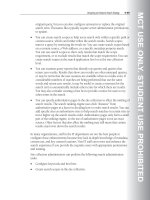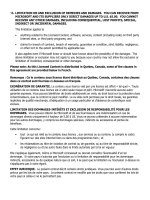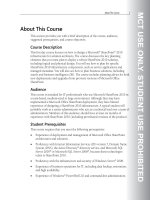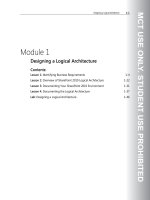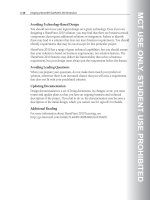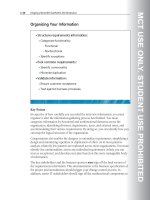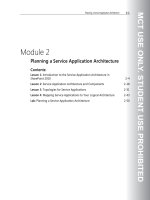Designing a Microsoft SharePoint 2010 Infrastructure Vol 1 part 24 doc
Bạn đang xem bản rút gọn của tài liệu. Xem và tải ngay bản đầy đủ của tài liệu tại đây (977.85 KB, 10 trang )
MCT USE ONLY. STUDENT USE PROHIBITED
Designing a Physical Architecture 4-27
Lesson 3
SharePoint Farm Topologies
This lesson reviews the options for a SharePoint farm topology. The flexibility of
the SharePoint topology enables solution architects to tailor each farm deployment
to the specific sizing and performance requirements of their organization.
Using SharePoint 2010, you may choose to deploy a single farm to service all
requirements. Alternatively, you may choose to deploy multiple farms based on
separating authoring and publishing processes or multiple farms for a
geographically distributed user base. In addition, multiple farms can share some
service applications, or a single farm can provide content requirements for several
different organizations simultaneously.
Objectives
After completing this lesson, you will be able to:
• Identify suitable topologies for single farms.
• Explain options for multiple farm topologies and cross-farm services.
MCT USE ONLY. STUDENT USE PROHIBITED
4-28 Designing a Microsoft® SharePoint® 2010 Infrastructure
• Identify topologies for multiple farms to support content publishing.
• Describe the support for multi-tenancy in SharePoint 2010.
MCT USE ONLY. STUDENT USE PROHIBITED
Designing a Physical Architecture 4-29
Single Farm Topologies
Key Points
Farm topology is extremely flexible in SharePoint 2010. For example, you can add
servers to a farm (scale out) to share existing services with the current farm servers.
You can also dedicate specific servers to running specific service applications, such
as search or Excel Services, or dedicate servers as WFE servers.
There are three categories of farm topologies:
• Small farms. These farms typically have between two and approximately five
servers, and they can have two or three tiers. In a small, two-tier farm, the
WFE server(s) also run service application components such as search query,
search crawl, or Microsoft InfoPath® forms. A small farm can serve between
10,000 to 20,000 users depending on usage and service requirements.
• Medium farms. These farms have between approximately five and 10 servers,
separated into three tiers. In medium farms, service applications are often
spread out across a number of application servers, with dedicated search
servers. A medium farm can manage up to 40 million items. You can extend a
medium farm by having more than one database server, with the search
databases separated from other SharePoint databases.
MCT USE ONLY. STUDENT USE PROHIBITED
4-30 Designing a Microsoft® SharePoint® 2010 Infrastructure
• Large farms. These farms typically start at approximately 10 servers and scale
out. The recommendation for scaling out a large farm is to group services or
databases with similar performance characteristics onto dedicated servers and
then scale out the servers as a group.
Note: Server groups are only a design concept—there is no such management object in
a SharePoint 2010 farm.
Question: In a medium farm with a single database server, you plan to add an
additional database server for performance reasons. Which service application
databases would you move to the new database server first?
Additional Reading
For more information about topologies for SharePoint 2010, see
MCT USE ONLY. STUDENT USE PROHIBITED
Designing a Physical Architecture 4-31
Multiple Farm Topologies and Cross-Farm Services
Key Points
In SharePoint 2010, you can share some service applications among different farms
in the same organization. This enables you to unify or standardize certain service
application–related elements.
For example, an organization may have two separate SharePoint farms for different
departments or geographic regions. In such an environment, you can create a
dedicated search farm that can crawl content from—and provide search results to—
both farms simultaneously. Scaling out in this way to multiple farms also provides
performance opportunities. For example, you can use a dedicated search farm to
scale for indexes that include more than 40 million items.
Cross-farm services are applications that can be shared independently with other
farms. Some service applications can be shared out to another farm and
simultaneously consumed from services running in other farms. For example, an
organization may have two farms that both use the Managed Metadata Service to
define metadata. Farm A can use the local Managed Metadata Service and consume
the Managed Metadata Service of Farm B, which makes both sets of metadata
MCT USE ONLY. STUDENT USE PROHIBITED
4-32 Designing a Microsoft® SharePoint® 2010 Infrastructure
available. You can repeat this configuration on Farm B so that both farms can share
metadata definitions.
By necessity, topologies for multiple farms increase the number of physical servers
that you require. However, farms that are dedicated to the provision of service
applications may not require any WFE servers. Due to the increased number of
servers required, multiple farm topologies are a good candidate for virtualization.
MCT USE ONLY. STUDENT USE PROHIBITED
Designing a Physical Architecture 4-33
Multiple Farms for Content Publishing
Key Points
Many organizations want to ensure a controlled distribution of content through an
authoring and review process before they make the content live in a production
environment. Organizations may consider deploying multiple farms to hold
content at different stages of this process.
An authoring farm enables content authors to make changes to content, and such
farms are often maintained on the internal network. Some parts of the review
process may take place while the content is only held here, and other reviews may
occur after the content moves to a staging environment.
Organizations can use a staging farm to hold a final draft of items before they move
them to a production environment. At the staging farm, final reviews for content
suitability, style, and layout can occur before they publish the item into general
circulation.
A production farm enables readers to browse final content without any crossover
with draft and authoring processes. You should only move content to the
production farm after all reviews are complete. You can place production farms in
a perimeter network for access from the Internet.
MCT USE ONLY. STUDENT USE PROHIBITED
4-34 Designing a Microsoft® SharePoint® 2010 Infrastructure
You can move content from one farm to the next in the process by using content
deployment to assist in automating elements of the process.
Note: The use of different server farms for authoring or staging purposes is typically only
suitable for publishing content, not collaboration content.
Some organizations will use additional farm environments, such as a development
farm and a testing farm. Organizations often use these farm environments when
additional coding requirements exist, such as in-house or third-party Web Parts.
Additional Reading
For more information about the topology of design content deployment, see
MCT USE ONLY. STUDENT USE PROHIBITED
Designing a Physical Architecture 4-35
Multi-Tenancy Environments
Key Points
SharePoint 2010 has significantly improved options for hosting providers.
Improvements in logical architecture enable you to implement farm deployments
that use a multi-tenancy model. Multi-tenancy means that different companies can
share a single farm environment.
This arrangement suits large organizations with subsidiary companies that have
specific requirements for SharePoint 2010. The parent company can provision and
manage a large farm with segregated content areas for the subsidiaries; the parent
company and the subsidiaries can combine investment in hardware and licensing
and share the benefits.
The multi-tenancy model also suits SharePoint hosting providers as part of a
commercial hosting model, where customer companies pay for SharePoint storage
and service provisioning.
In both cases, it is important to follow server guidelines and topology options to
provide sufficient levels of performance for end users.
MCT USE ONLY. STUDENT USE PROHIBITED
4-36 Designing a Microsoft® SharePoint® 2010 Infrastructure
Additional Reading
For more information about SharePoint 2010 for hosters, see
